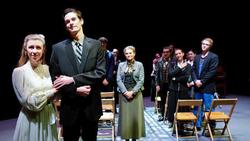A&E
Sold-out Our Town is bold, poignant
By Gabe Skoletsky ’17
May 1, 2015
The Hamilton College Theatre department graced the community with Thornton Wilder’s American classic, Our Town. Directed by Professor of Theatre Craig Latrell, this production conveyed the eccentricities of life in small town America with the raw talent of a cast and crew that sprung from the many diverse corners of Hamilton.
Our Town originally premiered in 1938 at the McCarter Theater in Princeton, New Jersey, and won the Pulitzer Prize for Drama. Wilder’s extended use of metatheatrical devices such as breaking the fourth wall, setting the show in the theater where it is performed and limited set design helped popularize then-experimental forms of storytelling in American theater. Interestingly, the lack of a modest attempt to create theatrical realism made it seem as if there was no fourth wall, or even a third, second or first. It appeared that Wilder had the intention of interrupting scenes or having characters directly interact with the audience to dismantle the illusion that his play is portraying something real. This deconstruction of realism allowed the audience to fully absorb even the subtlest of his ideas.
Despite the fact that Wilder included these techniques, it is challenging at times to observe this play as “lacking realism.” The combination of likeable characters and their constantly brilliant prose ensured that one had an emotional identification throughout the show. In the end, the successful character development tended to allow the audience to disregard Wilder’s clear attempt of dismantling a sense of realism.
Our Town features a friendly narrator known as the Stage Manager, played by Wynn Van Dusen ’15, welcoming the audience to the peculiar yet familiar world of Grover’s Corners, New Hampshire circa 1901. Van Dusen played an almost godlike role as the orchestrator of the play’s events and liaison between the world of Grover’s Corners and the audience. For the most part, Our Town features an exposé into the daily lives of Grove’s Corners’ archetypical characters, or, as the Stage Manager proclaimed, “This is the way we were: in our growing up and in our marrying and in our living and our dying.” Our Town manages to successfully keep its audience’s attention despite its modest premise because it focuses on those common vicissitudes and excitements of life.
The play’s most significant development is the love story between the protagonists, George Gibbs and Emily Webb, played by Charlie Wilson ’16 and Catherine Macleod Daigle ’17 respectively. While most characters tend to remain static amidst a changing world, George and Emily endure the most personal growth. Wilson and Macleod Daigle portray this coming of age aspect beautifully as two shy young lovers eventually learn their deep affection towards one another. As they grow older, the importance of daily life becomes subordinate to larger ceremonious activities such as marriage. Macleod Daigle convincingly portrayed this reality, and successfully conveyed the diverse spectrum of emotions associated with it. Her emotional journey resulted in perhaps the most important message of Our Town: “Do any human beings ever realize life while they live it?—every, every minute.” Throughout the show, the audience witnesses these characters’ ordinary moments, triumphant moments and their darkest moments along with them. Wilder’s quotation allowed the audience to ponder if they celebrated those ordinary moments just as much as the large ones. The emotional build up for that line had such prodigious impact because the audience became so absorbed into the gradual portrayal of events that could only lead to asking such a loaded question.
In addition to George and Emily’s overarching love story, the unique stories of Grover’s Corners’ ensemble of personalities created a likeable and relatable character for the town. Dr. Gibbs, played by Brian Evans ’15, is a doctor, father and Civil War expert who attempted to positively influence his extensive personal relationships. Evans played the role with the perfect amount of restraint and authority needed for a man who believed he is the master of his own world. Mrs. Gibbs, played by Lizzie Buchanan ’15, lives a simple life as a housewife and mother of two children. Although she remains relatively content about her life as a mother, her dream to travel to Paris created an intriguing window into the type of lifestyle Wilder is attempting to portray.
Perhaps the most unique aspect of the production was the effective use of digital media. At times, the implantation of digital media helped remedy the relatively bare stage that often had only a few pieces of furniture. Sometimes, technology provided glimpses of Grover’s Corners. Members of the audience could further familiarize themselves with the layout of the town as they saw images of shops popping up along a projection of Main Street. Other times, visual images created a stimulating atmosphere. Visually witnessing twinkling stars during a night scene may have provided an emotional attachment that Wilder likely hoped to avoid. Latrell’s decision to use digital media was particularly interesting because Wilder frequently attempted to ensure that the play did not feel too real. To an audience member, however, Latrell’s decision to include digital visualizations was a welcome addition amidst an otherwise minimalist production
Hamilton’s production of Our Town provides an emotional transportation to a fictional town that feels real to whomever decides to visit. Despite the fact that the lifestyle portrayed in the play only exists as memories within America’s past, Wilder manages to create character conflicts that still resonate with audiences nearly 80 years later. A masterful interpretation of Wilder’s works by the cast and crew ensured a successful production overall.





